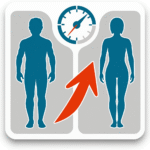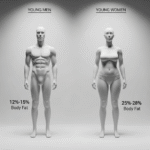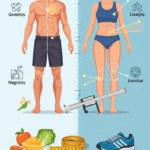Our Body Fat Calculator is 100% Free online to discover how to measure your body fat percentage and enhance your fitness journey with our comprehensive guide.
Body Fat Measurement Tool
Calculate your body fat percentage using multiple proven methods. Get insights into your body composition and health.
Body Fat Calculator
U.S. Navy Method
Uses height, neck, and waist measurements (and hips for women)
BMI-Based Method
Estimates body fat using BMI, age, and gender
Your Results
Interpretation
Your body fat percentage will be interpreted here based on your gender and age.
Method Used: U.S. Navy Method
About Body Fat Measurement
Why Measure Body Fat?
Body fat percentage is a more accurate indicator of health than weight alone. It helps assess fitness levels, track progress, and identify potential health risks associated with excess body fat.
Measurement Methods
- U.S. Navy Method: Uses circumference measurements to estimate body fat. Considered one of the most accurate tape-measure methods.
- BMI-Based Method: Estimates body fat using Body Mass Index along with age and gender factors.
- Skinfold Calipers: Measures thickness of skinfolds at specific body sites.
- Bioelectrical Impedance (BIA): Uses electrical signals to estimate body composition.
- DEXA Scan: Dual-energy X-ray absorptiometry, considered the gold standard for body composition analysis.
Tips for Accurate Measurement
Consistent Timing
Measure at the same time of day, preferably in the morning before eating or drinking.
Proper Tape Placement
Place the tape measure snugly but not compressing the skin. Keep it parallel to the floor.
Natural Stance
Stand naturally with feet together and arms at your sides. Breathe normally during measurement.
Multiple Measurements
Take each measurement 2-3 times and use the average for best accuracy.
Healthy Body Fat Ranges
For Men: Essential fat: 2-5%, Athletes: 6-13%, Fitness: 14-17%, Average: 18-24%, Obese: 25%+
For Women: Essential fat: 10-13%, Athletes: 14-20%, Fitness: 21-24%, Average: 25-31%, Obese: 32%+
Note: These ranges vary by age and individual factors.
Table of Contents
Discover the importance of a body fat calculator in assessing your health and fitness level. This comprehensive guide explains how to measure body fat percentage, the benefits of understanding body composition, and why regular monitoring is essential for maintaining overall health. Learn about various measurement methods, input parameters, and common myths surrounding body fat calculators. Enhance your fitness journey by focusing on body fat and making informed adjustments to your diet and exercise routine to achieve your wellness goals.
What is a Body Fat Calculator?

A body fat calculator is a tool designed to estimate the percentage of fat in an individual's body. It plays a crucial role in helping individuals assess their body composition, which is a vital aspect of overall health and fitness. Understanding body fat percentage is significant, as it can offer insights beyond mere body weight, indicating how much of an individual’s weight is constituted by fat versus lean mass, such as muscle and bone.
Various methods exist for calculating body fat percentage, each with its unique approach and accuracy level. Common techniques include skinfold measurements taken with calipers, bioelectrical impedance analysis (BIA), and DEXA scans. Skinfold measurements involve pinching the skin at specific body sites and measuring the thickness of the folds to estimate overall body fat. BIA, on the other hand, assesses body composition based on the electrical conductivity of body tissues, which vary between fat and lean mass. DEXA scans provide a detailed analysis by using X-ray technology to measure bone density and evaluate body composition, yet they may not be readily accessible to everyone due to cost and availability.
Recognizing one's body fat percentage can provide multiple health benefits. It allows individuals to track progress over time, adjust fitness plans accordingly, and set realistic goals related to weight loss, muscle gain, or overall health improvement. Body fat calculators also facilitate a better understanding of health risk factors associated with body composition. For example, higher body fat percentages may correlate with higher risks of certain chronic diseases. By utilizing a body fat calculator, individuals can take proactive steps toward achieving a balanced and healthy body composition.
Why Measure Body Fat?
In recent years, the shift from traditional weight tracking to more advanced metrics has highlighted the importance of measuring body fat percentage. Weight alone can be misleading; it does not provide a complete picture of an individual's body composition. Body fat percentage serves as a more accurate indicator of health, revealing not only the amount of fat present but also its potential implications on overall well-being.
Excess body fat, particularly visceral fat that surrounds internal organs, is closely linked to numerous health risks including obesity, cardiovascular diseases, and type 2 diabetes. These conditions often arise when body fat levels exceed what is considered healthy. By determining body fat percentage, individuals can understand their risk factors and take proactive measures in managing their health.
Conversely, having too little body fat can also pose significant health concerns. Extremely low body fat percentages can lead to hormonal imbalances, weakened immune function, and other metabolic issues. It is essential for individuals to strive for a body fat percentage that falls within the recommended ranges appropriate for their age, sex, and activity level.
Using body fat calculators can facilitate this process, offering individuals insights into their body composition that are not merely reflected by the scale. These tools allow for a more nuanced understanding of how changes in diet, exercise, and lifestyle impact body fat levels and overall health. By focusing on body fat percentage rather than weight alone, individuals can foster a healthier self-image and empower themselves with the knowledge needed to make informed health choices.
How Body Fat Calculators Work
Body fat calculators serve as useful tools in assessing an individual's body fat percentage, providing a clearer picture of overall health. These calculators utilize various formulas and methods, one of the most widely recognized being the US Navy method. This particular approach estimates body fat based on anthropometric measurements. It requires specific inputs such as gender, age, weight, height, neck, waist, and hip circumferences, each playing a pivotal role in the calculation.
The underlying principle of these calculators revolves around the fact that body composition can be inferred from physical measurements. For instance, the US Navy method employs different equations tailored for men and women, acknowledging the physiological differences in fat distribution. By inputting precise measurements, one can derive a body fat percentage that reflects their level of fitness.
To begin the calculation process, one must measure the neck circumference just below the larynx, as well as the waist circumference at the narrowest point. For women, the hip circumference is also required, measured at the widest part of the hips. These measurements are then inserted into the applicable formula. For men, the formula is typically structured as follows: body fat percentage = 86.010 * log10(waist circumference - neck circumference) - 70.041 * log10(height) + 36.76. Women use a slightly different formula that factors in hip circumference.
It is important to note that the accuracy of these calculations can vary based on individual differences. Factors such as muscle mass, distribution of body fat, and even hydration levels can affect the results. While body fat calculators provide valuable estimates, they should ideally be used in conjunction with other assessment methods and professional guidance to achieve a holistic understanding of one’s health.
Input Parameters for Body Fat Calculators
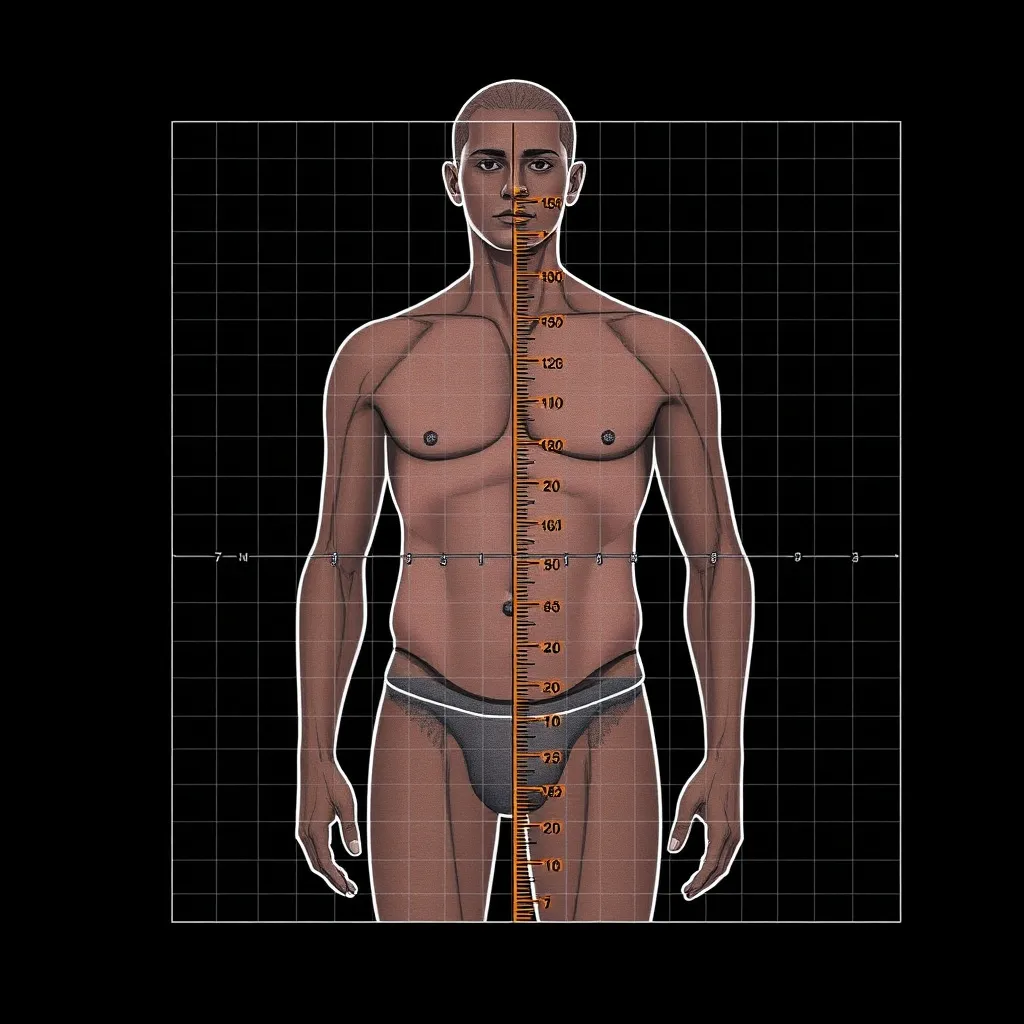
Body fat calculators are essential tools that provide users with an estimation of their body fat percentage based on various specific input parameters. To ensure accuracy in these estimations, several factors play a crucial role. Understanding these parameters is fundamental to grasping how body fat calculators function.
One of the primary parameters is gender. This factor is critical as physiological differences between males and females result in variations in body composition. Men generally have a lower body fat percentage compared to women, which reflects different hormonal balances and fat distribution patterns. Age is another vital parameter; as individuals age, their metabolism changes, often leading to a natural increase in body fat percentage, even when weight remains stable.
Weight, typically measured in kilograms, is also necessary as it serves as a foundational element in calculating body fat. Height, measured in centimeters, is equally significant; together with weight, these two parameters help to establish a person's Body Mass Index (BMI), which is often employed as a preliminary indicator of overall body health.
Furthermore, measurements of neck circumference, waist circumference, and hip circumference provide additional context to the calculations. The neck circumference helps determine fat distribution around the neck, signaling potential health risks. Waist circumference is crucial for assessing abdominal fat, which has been linked to higher risk factors for various chronic diseases. Hip circumference offers insights on fat distribution in the lower body. Collectively, these measurements enable a more precise assessment of body fat percentage, accounting for variations in body structure and fat distribution.
In essence, when inputting data into a body fat calculator, the accuracy of these estimations largely depends on the careful consideration of these parameters, emphasizing the need for comprehensive data collection to achieve reliable results.
Calculating Body Fat: Step-by-Step Guide
Calculating your body fat percentage can be a straightforward process if you follow a systematic approach. First and foremost, it is essential to gather the necessary tools. Typically, you will need a scale for your weight, a tape measure for your body measurements, and possibly calipers or a body fat scale if you prefer more precise readings.
The first step is to weigh yourself. Ensure that you are wearing minimal clothing and that you use the same scale each time for consistency. Note down your weight accurately. The next step is to take your measurements. Common measurements include waist, hips, neck, and sometimes limbs depending on the method you choose. It’s helpful to take these measurements at the same time of day, preferably in the morning, to maintain uniformity.
Once you have your weight and measurements, you need to enter this data into the body fat calculator. Many online calculators are available, and these tools will vary slightly in the information they require. Most frequently, they will ask for your weight, height, age, gender, and your measurements. Some calculators may also include options for activity levels, which can help in determining more nuanced body fat readings.
Ensure that any measurements you take are done accurately. For instance, when measuring your waist, it should be taken at the narrowest point, or at the level of your navel for consistency. It is crucial to pull the tape snugly, but not so tight that it compresses the skin. After entering your data into the body fat calculator, press the calculate button to receive your body fat percentage.
This calculated percentage will give you insights into your body composition, which can aid you in tracking your fitness goals more effectively. By following these steps carefully, you can ensure accurate and helpful results from your body fat calculation process.
Interpreting Your Body Fat Percentage
Understanding your body fat percentage is essential for assessing your overall health and fitness level. Body fat calculators provide an estimate of the proportion of fat in your body compared to lean mass, which includes muscle, bone, and water. The interpretation of these results varies based on age, gender, and fitness goals, making it crucial to analyze your percentage within these contexts.
Generally, body fat percentages are categorized as follows: for men, a body fat percentage of 2-5% is considered essential fat, 6-24% is regarded as healthy, 25-31% is classified as overweight, and anything above 32% is categorized as obese. For women, essential fat is typically 10-13%, with healthy body fat ranging from 14-31%. A body fat percentage between 32-37% is deemed overweight, while values exceeding 38% are classified as obese. These ranges reflect the differences in body composition between genders, influenced by hormonal factors and biological functions.
Aging also plays a significant role, as body fat percentages can increase with age due to muscle loss and hormonal changes. It is essential to consider these factors when using a body fat calculator. For instance, a 40-year-old man with a body fat percentage of 20% may be in a healthier range compared to a younger counterpart, while a 60-year-old woman with a similar percentage might need to evaluate her fitness strategies more closely.
Ultimately, while body fat calculators offer a useful guideline, individual health should be assessed based on a combination of factors, including diet, physical activity, and overall lifestyle. Regularly monitoring your body fat percentage can aid in setting realistic fitness goals and fostering long-term health habits. Understanding these nuances ensures that you can utilize your body fat percentage as a meaningful tool in your health journey.
Regular Monitoring and Adjustments
Monitoring body fat percentage regularly is a crucial aspect of managing one’s health and fitness over time. Body fat calculators serve as valuable tools that can provide insights into your current fitness state. However, relying solely on a singular measurement can be misleading. Changes in lifestyle, diet, and exercise routines can significantly influence body fat levels, necessitating periodic assessments.
Each individual's body composition is dynamic, influenced by various factors including age, metabolism, and overall activity levels. As such, it is essential to track changes in body fat regularly to obtain an accurate representation of one’s health. For instance, if a person adopts a new exercise regimen or alters their diet, these lifestyle changes can lead to fluctuations in body fat percentage. Regular monitoring allows individuals to identify patterns and make informed adjustments to their fitness plans and dietary habits.
It is also important to consider the context of these measurements. Body fat calculators can be affected by hydration levels, time of day, and even exercise intensity. Therefore, consistency in measurement conditions—such as measuring at the same time each day and under similar circumstances—can enhance accuracy and reliability of the results. Setting short-term goals based on these measurements promotes motivation and guides appropriate adjustments in health strategies.
In summary, regular monitoring of body fat levels provides critical information that can drive better health and wellness outcomes. By understanding how diet, exercise routines, and lifestyle choices impact body fat percentage, individuals can make necessary changes to their health plans, ultimately fostering a more informed and proactive approach to their fitness journey.
Common Myths About Body Fat Calculators
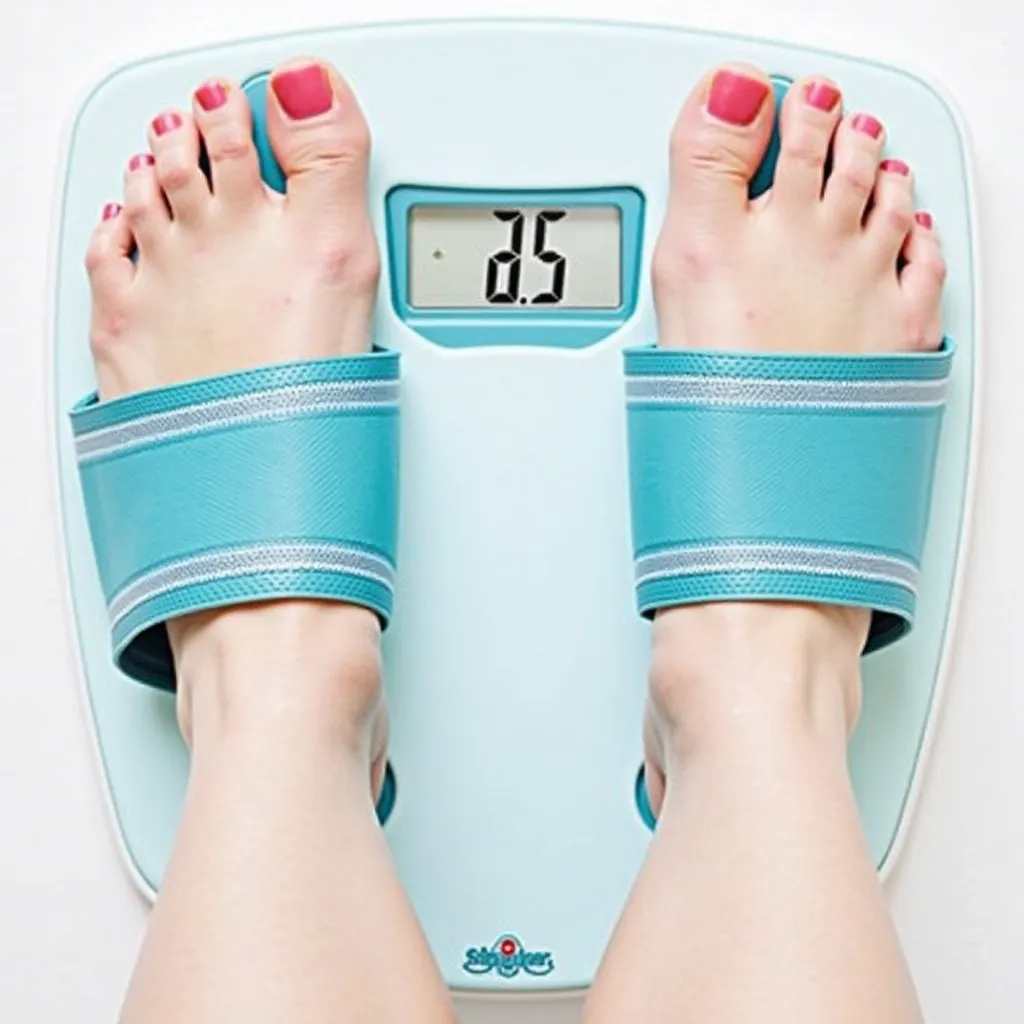
Body fat calculators have become increasingly popular as more individuals seek to understand their body composition. However, several myths surrounding these tools can lead to misunderstandings and misuse. One of the most prevalent myths is the belief that these calculators provide completely accurate measurements of body fat percentage. In reality, various factors such as the method of calculation, the time of day, and individual variations can influence the results. Although tools like skinfold calipers and bioelectrical impedance scales offer estimates, they cannot account for all variables affecting body fat. Therefore, while they can serve as useful indicators, they should not be taken as definitive measurements.
Another common misconception is the over-reliance on body fat calculators as the singular means of tracking fitness progress. While monitoring body fat percentage is valuable, it is crucial to consider other aspects of health, such as muscle mass, overall weight, and physical performance. Focusing solely on body fat can lead to an unhealthy mindset that emphasizes numbers over overall well-being. A more balanced approach takes into account the various components of fitness and health, promoting a holistic view rather than a numerically defined one.
Furthermore, many people confuse body weight with body composition, leading to misguided interpretations of fitness levels. Body weight alone does not provide a comprehensive picture of an individual’s health. Two individuals may weigh the same yet have vastly different body fat percentages. Understanding the distinction between weight and body composition is essential for interpreting the data provided by body fat calculators accurately. By dispelling these myths, individuals can better utilize body fat calculators to inform their health and fitness journeys while maintaining a broader perspective on wellness.
Conclusion: The Role of Body Fat Calculators in Your Fitness Journey
Body fat calculators serve as essential tools in the pursuit of health and fitness objectives. Throughout this comprehensive guide, we have explored how these calculators provide valuable insights into an individual's body composition, going beyond mere weight measurements. Understanding body fat percentage is crucial as it can influence overall health, athletic performance, and well-being.
Regular assessment of body fat can help individuals recognize changes in their body composition, allowing for timely adjustments to diet and exercise regimens. By monitoring these fluctuations, one can effectively track progress towards fitness goals, enhance motivation, and make informed decisions about lifestyle changes. The outcomes of using body fat calculators are particularly significant for those engaged in weight management or fitness training, as these figures can guide tailored workout and dietary strategies to attain specific results.
Incorporating body fat assessments into one's routine encourages a holistic approach to health. Rather than focusing solely on weight loss, individuals can shift their attention toward reducing body fat while maintaining or gaining muscle mass. This notion is vital since higher muscle mass can lead to improved metabolism and overall health, further emphasizing the role these calculators play in advancing one's fitness journey.
In summary, the importance of body fat calculators cannot be overstated. They facilitate a deeper understanding of individual health, empower individuals to set and achieve targeted fitness goals, and aid in maintaining overall well-being. By actively using these calculators, individuals can cultivate habits that foster healthy living in the long term, making body fat assessments a cornerstone of a successful fitness journey.






